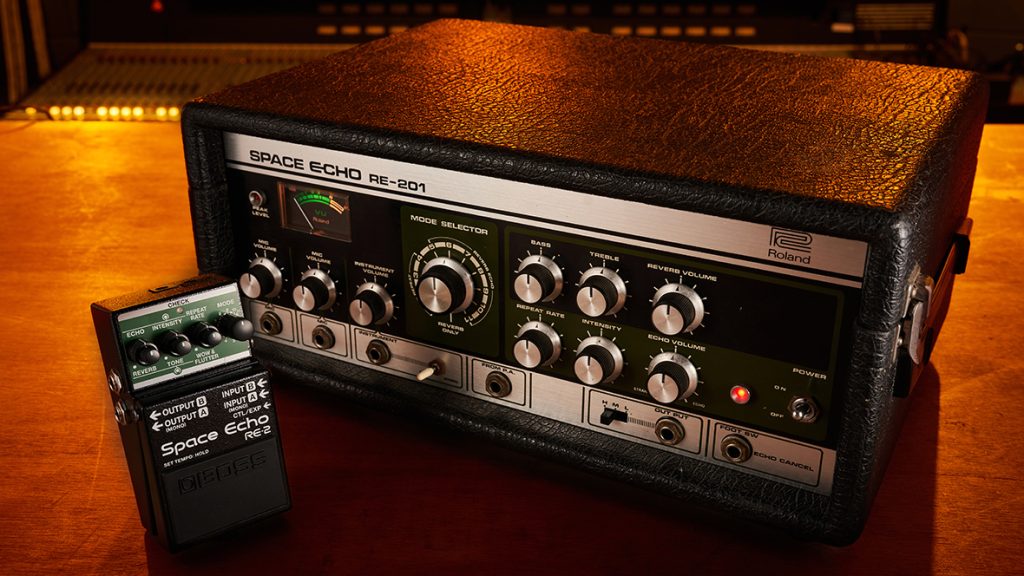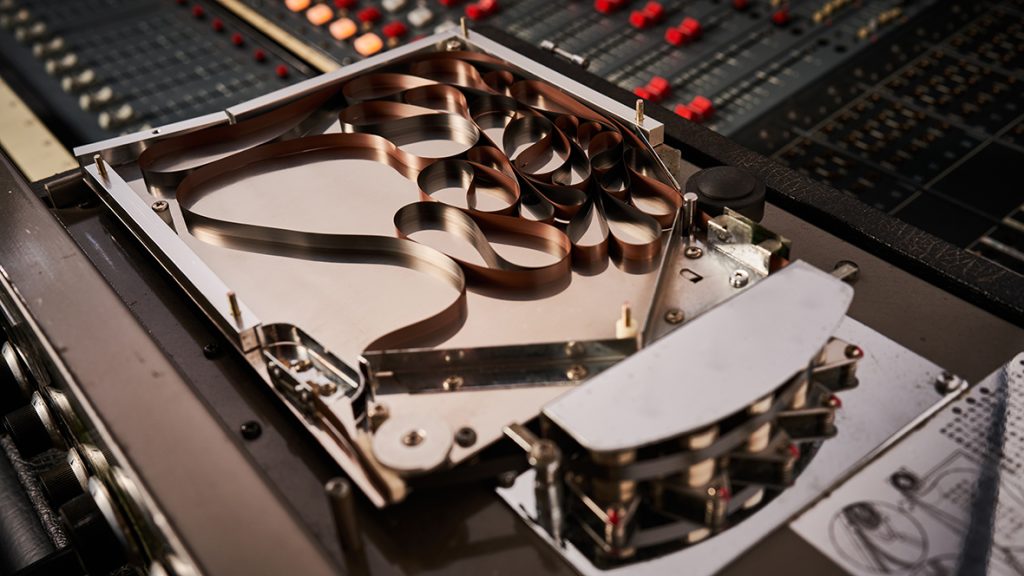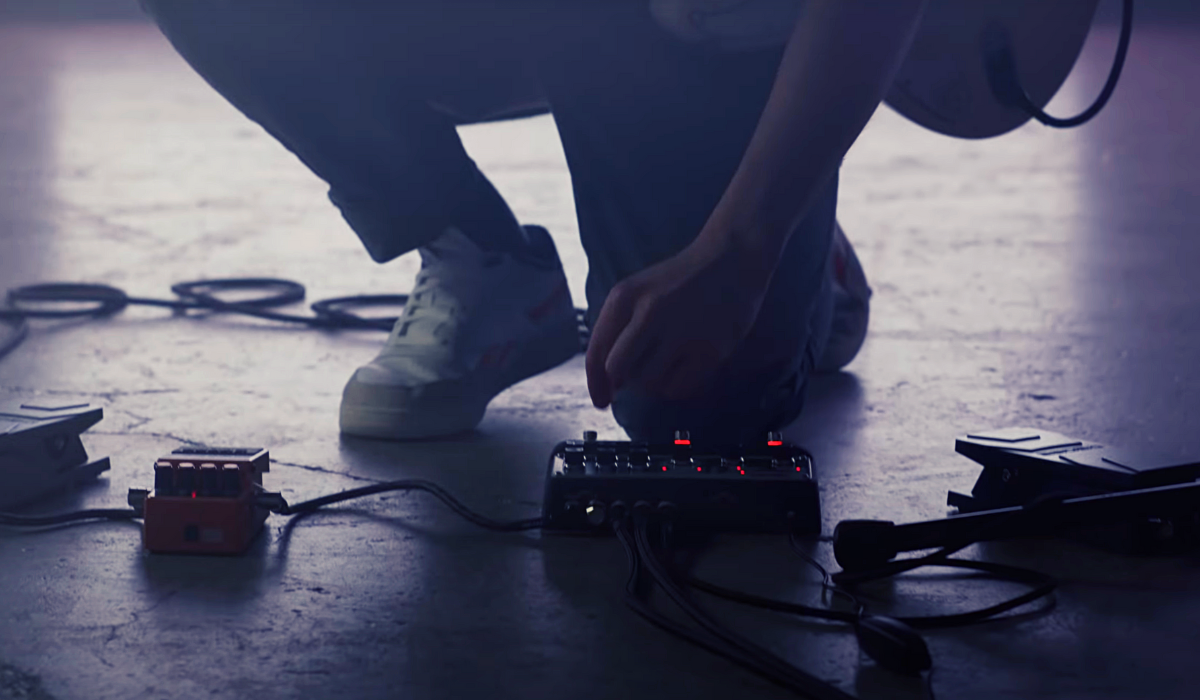Delay is an essential tool in any musician’s arsenal, but there are considerations depending on what genre you play. Here are some delay pedal genre tips to help you get the right pedal for your needs. There are no right or wrong answers when it comes to music. However, there’s always an ideal sound, and these BOSS delay pedals will get you there. From crisp digital repeats to warm, atmospheric trails, explore the best delays for shoegaze, rock, metal, jazz, worship, and more.
What Genres Use Delay?
The genres that use delay the most are shoegaze, dub and reggae music, metal, especially technical metal, classic rock, and worship. Jazz and blues use the effect sporadically as a reverb for delay-style sound, pairing it with overdrive. Pairing delay with overdrive is one of the best ways to make the most of both pedals.
"For shoegaze, you want tape saturation, analog warmth, and a saturated signal, but you want to be able to control it as well."
Shoegaze
For shoegaze delay, we recommend the DD-8, the DM-101, the DD-200, and the RE-202. These give you multiple options, precision timing, and digital reliability with analog functionality. The best shoegaze delay allows multiple repeats with elongated delay times and ambience. It should have shimmer effects and modulation, and, ideally, stereo functionality. You want tape saturation, analog warmth, and a saturated signal, but you want to be able to control it as well.
The DD-8 has tap tempo functionality if you need to claw back the timing. It also has multiple delay modes, including reverse and shimmer mode, which shoegaze bands use. The DM-101 has 12 delay modes ranging from vintage-style tape delays to more modern doubling delays inspired by the digital era. However, the ambient tone is what shoegaze guitarists will love, allowing you to fill a room with lush, ethereal sounds.
The DD-200 has 12 different delay modes, including shimmer and the ability to run a dual delay. By contrast, the RE-202 provides that classic tape echo with added warmth and warble that you can hear on Boards of Canada albums. You also get stereo functionality and can use multiple delay patterns on the DD-200 and the DM-101. It makes it sound like there are more guitars onstage, creating that wall-of-sound shoegaze effect.
"Looking for an immersive shoegaze delay for rhythm lines? Use the RE-202 or BOSS DD-500."
Shoegaze Delay Settings
For an ambient shoegaze delay, the BOSS DD-200’s Pad Echo mode is perfect. Set the time range of 500-700 ms with very high feedback for 8-10 repeats and a high effect level that pushes you firmly into the shoegaze world.
Looking for an immersive shoegaze delay for rhythm lines? Use the RE-202, DD-500, or any other delay with some modulation or reverb with a time of 400-600 ms, high feedback for 6-8 repeats, and a high effect level. Then, adjust your EQ so the bass notes don’t drown out the high-end frequencies.
Rock and Metal
Two great delay pedals for rock and metal are the DD-3T or DD-8. For rock and metal genres, you’ll want a powerful and aggressive sound. A digital delay pedal such as the BOSS DD-3T with tap tempo, or DD-8 with additional time intervals will work well. These offer precision, the versatility you need, as well as a simple interface to get the sound you want quickly. Slash is one of the most famous delay pedal artists and used it on Appetite For Destruction, including the intro to “Welcome To The Jungle.”
Benefits of digital delay for rock and metal include tight, rhythmic echoes or sweeping soundscapes without muddying the signal. Pair a delay with an overdrive like the SD-1 for rock. For metal, try a delay with a distortion pedal like the MT-2 Metal Zone. Then, use moderate to high feedback levels to create an intense sound that cuts through the mix with clarity. However, for a classic rock vibe, like The Darkness, Pink Floyd, Deep Purple, or later era Black Sabbath, try an analog delay with that warmer, more subtle nuance feel that degrades each time. Just set the level back so it doesn’t drown out your sound.
"Pair a delay with an overdrive like the SD-1 for rock. For metal, try a delay with a distortion pedal like the MT-2 Metal Zone."
Metal Delay Settings
For heavy metal delay pedal settings where you’ll be tremolo picking or riffing hard, you don’t want the delay to overtake your sound. Set the feedback (repeats) to one or two, the delay time to 300-800 ms, and the level to about 10 o’clock so it sits underneath the main sound.
Rock Delay Settings
If you want classic rock settings, especially where there’s a solo involved, use a moderate delay time (around 300-500 ms) with a low to moderate feedback level (two or three repeats) and a low mix level. Increase the mix depending on whether you want the delay to be a feature or a supporting element.

Jazz
The best delay pedal for jazz would be either a digital delay like the DD-8 or an analog delay like the DM-2W. Both can give the instant slapback delay jazz guitarists tend to gravitate towards to fill the gaps and bolster the sound of single guitars. Jazz often demands a more sophisticated and nuanced sound. As such, it’s not always the genre that reaches for a delay pedal. This is especially the case as the hollow body guitars, often favored by jazz players, can feed back.
Analog delay pedals like the DM-2W offer warm repeats that can add depth without overpowering the intricate dynamics of jazz. They add a feel or warmth to the sound of solo runs or chords if needed. For longer delay times, set a longer delay time with lower feedback on the DD-8 for a gentle echo that enhances solos and chord progressions. This gives a sense of space and expression while remaining crystal clear, crisp, and, of course, highly controllable.
"Use overdrives and preamp pedals ahead of the delay to keep those delay tails crisp
and clear."
If you’re a fusion player, you’ll appreciate the hold function. It not only remains clear when you’re playing but also accentuates specific notes you hold. Its stereo output is also ideal for use with a stereo amp setup.
Jazz Delay Settings
Jazz players don’t want too many repeats and don’t want the delay overtaking their notes, so the shorter the delay, the better. Set the effects level to a low setting, the feedback to one or two repeats, and the delay time as short as possible to get a more reverb-style slapback delay.
Worship
For worship, the best choices would be the DD-200, RE-2, or DM-101. The DD-200 offers superb digital accuracy and ethereal simmer delay. Or try the RE-2 with its modulated tape warble or the DM-101, which features 12 analog delay sounds that include a lush mix of mono and stereo outputs.
Worship music and worship guitarists love to create an ethereal and emotional atmosphere with their delay pedals. They need something that can traverse multiple delay styles and give a massive sonic canvas. A delay pedal with a tape echo setting, such as the BOSS RE-2, can provide lush, ambient echoes that offer a unique warble. When you combine this with reverb and modulation effects, the sound will resonate with the uplifting themes of worship music.
"A critical feature worship guitarists want is the shimmer setting. It provides pitch-shifted delay for lush textures."

The DD-200 Digital Delay Pedal is one of the most powerful multi-delay pedals for worship guitarists who want to access varied sounds. A critical feature worship guitarists want is the shimmer setting. It provides pitch-shifted delay for lush textures like “With or Without You” by U2. The DD-200 has Standard, Analog, Tape, Drum, Shimmer, Tera Echo, Pad Echo, Pattern, Lo-Fi, Dual, Ducking, and Reverse delay effects. There is also tap tempo, 4+ memory banks, and total control over each parameter, which means you’re ready for any song. The MIDI connectivity means you can lock in with onstage DAWs or backing tracks. This feature is especially useful in a live worship environment.
If you prefer the sound of analog delay, then the DM-101 is the absolute gold standard multi-delay pedal and one of the best delay pedals for worship. With 12 modes, from vintage to modern, including ambience, dual mode, pan, and pattern delay, there are plenty of options. It also supports MIDI I/O using mini TRS connectors and has a stereo output with flexible signal routing options. The DM-101 is ideal for worship guitarists who want the functionality and precision of digital with the sound and nuance of analog.
Worship Delay Settings
If you want ethereal delay settings, find a pedal with shimmer. Then set the effect level to 1 o’clock so it’s slightly louder than your original signal. Set the feedback to one o’clock for the 800-1200 ms delay, and the repeats to three or four to make single-note lead lines stand out.
Blues
The best delay pedals for blues are digital delays, such as the DD-3T and DD-8, or analog delays, such as the RE-2 and DM-101. Blues players will appreciate the tap tempo functionality on these pedals as no blues session is the same tempo and can change on the fly. The RE-2 gives you the classic tape delay sound. The DM-101 gives you that analog warmth with multiple delay options and superb control. The DD-3T is your no-fuss digital delay with 3-speed settings, and the DD-8 has multiple delay modes if you want to expand your sonic palette.
As mentioned, blues sounds best with a subtle touch of delay rather than an utterly saturated tone. The warm, organic repeats of a mild analog or tape delay, like the DM-101 or RE-2, will blend smoothly in a mix. Still, it can take over the sonic spectrum for psych-blues freakouts or Pink Floyd-esque solos. If you like the sound of vintage-style blues, these are for you.

Digital delays like the DD-3T and the DD-8 have a smaller footprint and can give you everything from subtle slapback to delay for reverb and country-style delay tones. If you want to retain as much original signal clarity as possible, then a digital delay might be better. If the John Mayer style ’80s rock/blues tone is more your thing, digital delay might be the best choice.
For the accuracy of MIDI functionality and triggering with analog nuance, the DM-101 is an excellent choice for blues players seeking control and customization. You get 12 different modes and a variety of tone-shaping controls. With settings like Reflect, the DM-101 provides warm, authentic echoes that can blend effortlessly with the soulful tones of blues music.
"With settings like Reflect, the DM-101 provides warm, authentic echoes that can blend effortlessly with the soulful tones of blues music."
Blues Delay Settings
For faster rock and blues, you’ll want a slapback and moderate delay. Set the time to 250-350 ms, a low repeat, and the effect level to moderate so it blends nicely with the dry signal without overtaking it. For a spacious lead tone, crank the feedback (two or three repeats) and increase the time to around 400 ms. For slow blues, select a vintage style delay with a time of 400-500 ms, moderate feedback, and an effect level equal to your dry signal.
Reggae
The best delay pedals for reggae/dub are the DD-3T for that classic dub effect, the DD-8 with tape echo for warmth, the DD-200 with multi-head space echo, and the RE-2 for that authentic vintage dub sound with tape delay modulation.
Reggae music often uses delay to create rhythmic and spacey effects with more repeats than blues or country. A delay pedal that can sync to the beat, such as the DD-3T with its tap tempo function, is best. You can maintain the tempo while allowing your delay to shine. Experimenting with short delay times, high feedback, and a level that degrades quickly through a stereo setup will get you that “dub” sound, where echoes bounce between the left and right channels.
"The key to dub is lengthy repeats, tape saturation with slight modulation, and a signal that doesn't overwhelm your sound."
Again, delay pedals like the DD-3T will give you the classic dub echo, controllable by the tap tempo, so your signal doesn’t become muddy. If you want more warmth or tape echo styling with digital reliability and modulation effects, the DD-200 and DD-500 pedals are also ideal. Finally, the RE-2 will give you a vintage dub sound that degrades with natural tape style wow and flutter and rich tonality.
The key to dub is lengthy repeats, tape saturation with slight modulation, and a signal that doesn’t overwhelm your sound. This was the rhythm will remain tight. You might prefer analog to digital delay or vice versa.

Infinite Possibilities
There are infinite possibilities when it comes to the best delay pedals for genres, so my advice is to try and get the best option for your unique sound. You may be a metal player and love analog delay that starts to self-oscillate and muddy your sound, or you might prefer crisp digital delays. Perhaps you’re a blues player who wants a more saturated delay tone for spacey freakouts. There are no rules. Go for what sounds best, or emulate the way your favorite artists use delay. See how they’ve been using delay in unique ways that set them apart from other artists.






